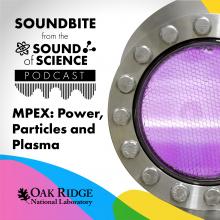Soundbite: MPEX: Power, particles and plasma

Soundbite: In our last episode, you heard about how scientists are working to harness the power of the sun on earth with fusion. Achieving fusion on a large scale could bring about a new age of unlimited, carbon-free energy. Scientists are getting closer to making this a reality, but there are still a few hurdles to overcome. One of those is finding materials that can withstand the insane conditions of a fusion reaction. Oak Ridge National Laboratory already has unique capabilities for testing these materials with the High Flux Isotope Reactor, or HFIR. While a fission reactor like HFIR produces some pretty extreme conditions, it’s still no match for what a material will experience inside a fusion reactor. That’s where the Material Plasma Exposure eXperiment, or MPEX, project at ORNL comes in. Hear how scientists like Juergen Rapp will use MPEX to take materials testing to the next level.
Transcript
[THEME MUSIC]
JENNY: Hello everyone, and welcome to a Soundbite from “The Sound of Science.”
MORGAN: A shorter installment of Oak Ridge National Laboratory’s podcast series.
[MUSIC TRANSITION]
JENNY: In our last episode, you heard about how scientists are working to harness the power of the sun on earth with fusion.
MORGAN: Achieving fusion on a large scale could bring about a new age of unlimited, carbon-free energy.
JENNY: Scientists are getting closer to making this a reality, but there are still a few hurdles to overcome.
MORGAN: One of those is finding materials that can withstand the insane conditions of a fusion reaction.
JENNY: We’re talking about temperatures hotter than the center of the sun. Magnetic fields hundreds of thousands of times stronger than the Earth’s. Neutrons energetic enough to change the structure of a material entirely.
MORGAN: ORNL already has unique capabilities for testing these materials with the High Flux Isotope Reactor, or HFIR.
JENNY: While a fission reactor like HFIR produces some pretty extreme conditions, it’s still no match for what a material will experience inside a fusion reactor.
MORGAN: That’s where the Material Plasma Exposure eXperiment, or MPEX, project at ORNL comes in.
JENNY: MPEX will allow researchers like Juergen Rapp to take materials testing to the next level.
JUERGEN RAPP: MPEX is a device which essentially mimics the power and particle exhaust system of a fusion reactor. So, it addresses one critical challenge on the way to a fusion reactor, we need to test materials for this power exhaust and particle exhaust system. And in order not to build a giant costly reactor, we do this in a much more compact form.
MORAN: The MPEX project started in 2010 and in 2014, the team produced a small-scale prototype, aptly named Proto-MPEX.
JENNY: After years of successful tests with Proto-MPEX, it’s now time to build the real deal.
MORGAN: MPEX is slated to come online in 2027. And while it will simulate the conditions of a fusion reactor, the plasma is not confined to the donut-shaped tokamak we described in our last episode.
JENNY: The device is cylindrical and about 65 feet long and has some pretty powerful magnets inside.
RAPP: Here the plasma is not doughnut shaped. It's in a linear arrangement and we produce a high-density plasma, which subsequently heated with microwaves and radio frequency waves to, you know, the conditions we need to recreate the plasma of a fusion reactor. We have also magnetic fields just like in a fusion reactor. And the diameter of those magnets, they are a little bit larger of that what is a typical MRI, I would say it's like, you know, an MRI for a horse, so you have a larger inner diameter, just such that we can have the access with all our diagnostics to really investigate the interaction of that high intensity plasma with the material, because we want to see how it changes, in situ, in real time, we want to see how the surface modifies, how it erodes, and if it disintegrates. So those are very critical questions, we have to address on the way to a fusion reactor.
MORGAN: Juergen and his colleagues will use MPEX in tandem with facilities like HFIR to accelerate their fusion materials research.
RAPP: MPEX will be unique in the sense that it can expose materials to fusion reactor relevant plasmas, but with materials which have been previously irradiated by neutrons, and Oak Ridge National Laboratory has the ability to expose those materials in its High Flux Isotope Reactor, so we here in the laboratory can actually irradiate the materials and then expose them later to plasmas.
JENNY: While there are still challenges to overcome to achieve fusion on a commercial level, projects like MPEX are helping get us one step closer to that reality.
MORGAN: Which is incredibly exciting – especially to those in the field.
RAPP: I'm very passionate about fusion, particularly when we look at, you know, our climate problem, which we have and fusion is really a process which could help us here. It has taken a long time, but I think it's worth it. And we are now at a step where we actually can make a difference.
[MUSIC TRANSITION]
JENNY: Thank you for listening to this Soundbite from The Sound of Science.
MORGAN: We hope you enjoyed it and will let us know how we’re doing by leaving a review.
JENNY: Don’t forget to subscribe to the series wherever you get your podcasts so you don’t miss an episode.
MORGAN: And if you want to keep up with the latest news from ORNL – about fusion and other exciting science areas at the lab – follow us on Twitter at @ORNL.
JENNY: Until next time!

